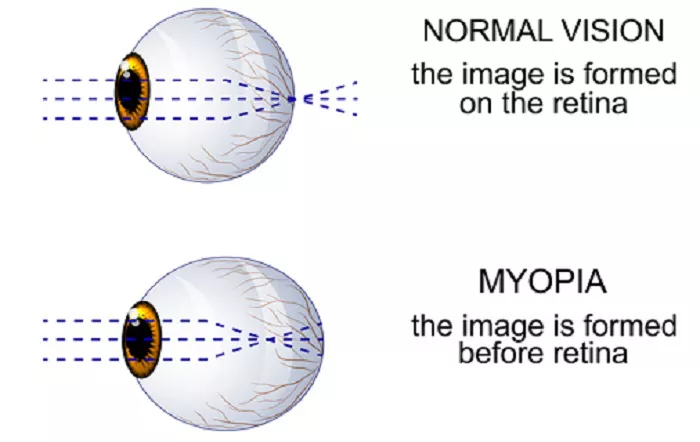Shortsightedness, medically known as myopia, affects millions worldwide who struggle with blurry distance vision. This comprehensive guide explores all current methods for how to correct shortsightedness, from traditional glasses to cutting-edge surgical procedures. Whether you’re looking for temporary solutions or permanent fixes, we’ll help you understand all your options.
What Causes Shortsightedness?
The Science Behind Myopia
Myopia occurs when:
- The eyeball grows too long front-to-back
- The cornea becomes too steeply curved
- The eye’s lens becomes too thick
These changes cause light rays to focus in front of the retina rather than directly on it.
Risk Factors for Developing Myopia
- Genetic predisposition (family history)
- Excessive near work (reading, screens)
- Limited outdoor activity during childhood
- Certain medical conditions like diabetes
Traditional Correction Methods
1. Prescription Eyeglasses
Concave lenses that diverge light before it enters the eye:
- Most affordable option
- Wide variety of styles available
- No direct contact with eyes
2. Contact Lenses
Thin plastic discs that sit directly on the eye:
- Provide wider field of view than glasses
- Available as dailies, monthlies, or extended wear
- Specialized options for high prescriptions
Advanced Non-Surgical Options
1. Orthokeratology (Ortho-K)
Special rigid gas permeable lenses worn overnight to temporarily reshape the cornea:
- Provides clear daytime vision without lenses
- May slow myopia progression in children
- Fully reversible treatment
2. Atropine Eye Drops
Low-concentration prescription drops that may:
- Slow myopia progression in children
- Reduce eye elongation
- Used in combination with other treatments
Surgical Correction Options
1. LASIK Eye Surgery
Laser reshaping of the cornea:
- Quick procedure (about 15 minutes per eye)
- Fast recovery (1-2 days)
- Suitable for mild to moderate myopia
2. PRK (Photorefractive Keratectomy)
Surface laser treatment alternative to LASIK:
- Better for thin corneas
- Longer recovery (several days to weeks)
- Excellent long-term results
3. ICL (Implantable Collamer Lens)
Permanent contact lens implanted inside the eye:
- Ideal for high myopia
- Doesn’t alter corneal structure
- Potentially reversible
Natural Approaches and Lifestyle Changes
1. The 20-20-20 Rule
Every 20 minutes, look at something 20 feet away for 20 seconds to reduce eye strain.
2. Increased Outdoor Time
Studies show children who spend more time outdoors have lower myopia risk.
3. Eye Exercises
While not proven to reverse myopia, these may help with eye fatigue:
- Pencil push-ups (focusing exercises)
- Figure-eight tracking
- Near-far focusing
Special Considerations for Children
1. Myopia Control Strategies
Options to slow progression in growing children:
- Specialized multifocal contact lenses
- Ortho-K lenses
- Atropine therapy
2. Importance of Regular Eye Exams
Children should have comprehensive eye exams:
- Before starting school
- Every 1-2 years thereafter
- More frequently if myopia is progressing
Emerging Technologies and Future Treatments
1. Light Therapy Glasses
Experimental devices that use specific light wavelengths to potentially slow eye growth.
2. Pharmacological Advances
New formulations of eye drops under investigation for myopia control.
3. Gene Therapy Research
Early-stage studies exploring genetic factors in myopia development.
Choosing the Right Correction Method for You
Factors to Consider
- Your age and lifestyle
- Degree of myopia
- Budget and insurance coverage
- Personal comfort with different options
Consultation with an Eye Specialist
A comprehensive eye exam will determine:
- Your exact prescription
- Corneal thickness and eye health
- Best treatment options for your case
Potential Risks and Complications
With Corrective Lenses
- Eye infections (contacts)
- Discomfort or headaches
- Dependency on correction
With Surgical Options
- Dry eyes
- Night vision problems
- Undercorrection/overcorrection
Maintaining Eye Health After Correction
1. Regular Eye Exams
Even after successful treatment, annual check-ups are essential.
2. Proper UV Protection
Wear sunglasses with 100% UV protection to prevent further damage.
3. Healthy Lifestyle Habits
Nutrition rich in vitamins A, C, E and omega-3s supports eye health.
Conclusion
Understanding how to correct shortsightedness involves evaluating multiple options based on your individual needs. From simple glasses to advanced surgical procedures, modern ophthalmology offers solutions for nearly every degree of myopia. Consult with an eye care professional to determine which method will give you the clearest, most comfortable vision for your lifestyle.
Related topics:


